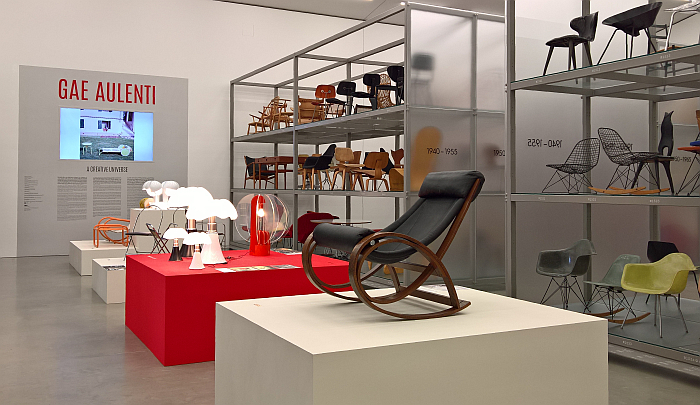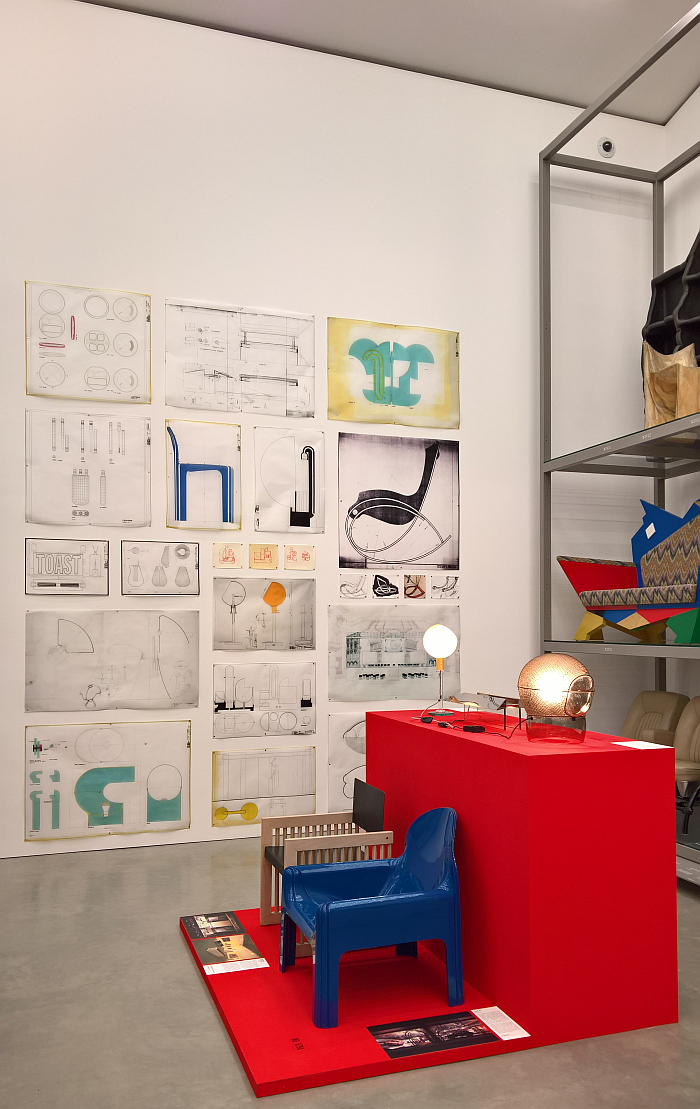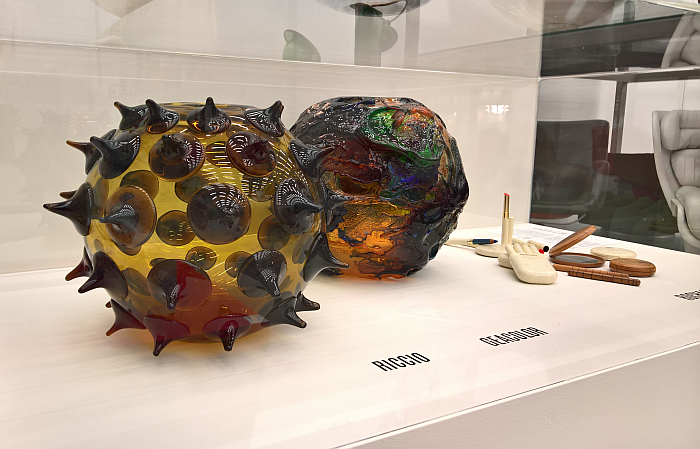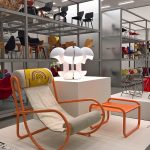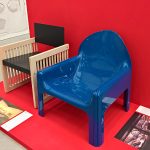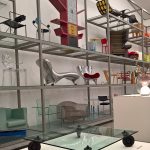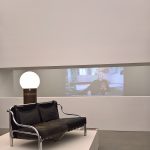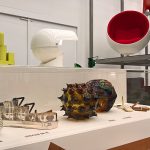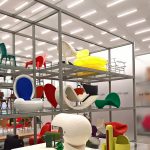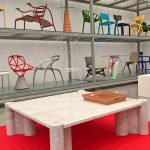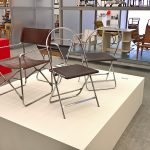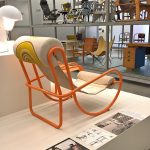Gae Aulenti: A Creative Universe at the Vitra Design Museum Schaudepot, Weil am Rhein
“It’s not possible to define a style in my work”1, opined once the Italian architect and designer Gae Aulenti.
With the exhibition Gae Aulenti: A Creative Universe, the Vitra Design Museum Schaudepot don’t contradict that opinion, but do provide for a framework for considerations on its validity……
Born in Palazzolo dello Stella (Udine) on December 4th 1927 Gaetana “Gae” Aulenti studied architecture at the Politecnico Milano, graduating in 1953, and thus graduating into that post-War period of economic rebirth and reconstruction in Italy; a period which on the one hand became il miracolo economico, the economic miracle, in the course of which the once largely agrarian Italy became increasingly industrialised, increasingly global in its trading and networks, and increasingly a by-word for high-quality contemporary product and industrial design, but also that period which, as we noted in context of the 1972 MoMA New York Exhibition Italy: A New Domestic Landscape, saw Italian architects and designers begin to increasingly question not only the nature, forms and context of the buildings and urban spaces being realised, but the products and objects they were designing, why they were designing them and for whom.
Questions that were to find answers in moments such as Anti-design, Radicalism or Memphis and wider Postmodernism. And debates on the what, why and whomfor2 regularly, and vociferously, undertaken in the pages of Italian architecture magazines, including Casabella, for whom between 1955 and 1965 Gae Aulenti served as a contributing editor, under the editorship of Ernesto Nathan Rogers, a leading proponent of so-called Neoliberty: the bygone “liberty” being Stile Liberty, Italian Art Nouveau; Neoliberty, and generalising to the point of inaccuracy, appealing for a move away from many of the tenets of inter-War modernism, away from Razionalismo, and a return to more historic principles, approaches and aesthetics, to the formal and decorative understandings of the late 19th/early 20th century, to paragons such as the Mackintosh Baronial, the Lloyd Wright Prairie or the Berlage Dutch Brick, albeit, and as such antecedents had also behaved, in context of the prevailing realities of the period.
In 1964 Ernesto Nathan Rogers was appointed Professor at the Politecnico Milano, Gae Aulenti serving as his assistant until his death in 1969, and in the same period she not only served as vice-president of the Italian Association for Industrial Design, ADI, but began to undertake ever larger commissions including, for example, creating the scenography for the Italian section at the 1964 Milan Triennial, designing showrooms and trade fair stands for Fiat, and developing the interiors for the Olivetti showrooms in Paris and Buenos Aires; before being invited, as the only solo female,3 to contribute an installation to the Environments section of A New Domestic Landscape, and for which she realised a domestic space which, if we’ve understood correctly, which as ever isn’t necessarily the case, was intended to evolve, develop, its functionality, its understanding of itself, through use rather than arrive with a pre-defined functionality, or as Gae Aulenti noted in the catalogue, was a space “made up of elements so composed as always to make their original purpose evident, while at the same time remaining open to a determination of their future purposes.”4
In the course of the 1970s Gae Aulenti increasingly became involved in theatre and stage design, most notably in collaboration with the director Luca Ronconi, but also realising numerous scenographies for Milan’s Scala opera house, before in 1980 she was awarded the architectural commission for which she is most popularly known: the conversion of the Gare d’Orsay in Paris into the Musée d’Orsay in Paris, a conversion which saw her retain much of the original architecture and detailing, and through a series of subtle, and occasionally less subtle, interventions re-configuring, re-imagining, the space from a 20th century railway station to a 21st century museum.
The Musée d’Orsay also in many regards marked Gae Aulenti’s international breakthrough as an architect, the following three decades seeing her realise projects as diverse as, and amongst many, many, others, the renovation/conversion of the Palau Nacional to the Museu Nacional d’Art de Catalunya in Barcelona, the restoration of the Palazzo Grassi in Venice, the construction of the Italian Institute of Culture in Tokyo, and an extension of the San Francesco d’Assisi – Umbria International Airport in Perugia.
Gae Aulenti died in Milan on October 31st 2012 aged 84.
Gae Aulenti’s first furniture designs were presented in context of the exhibition Nuovi disegni per il mobile italiano staged in March 1960 at the L’Osservatore delle arti industriali in Milan, a showcase very much in context of Neoliberty, and which as the exhibition catalogue notes wasn’t conceived as “an informative report on the work of the younger generations of Italian architects, nor the manifesto of a new trend” but much more was about propagating understandings of objects, relationship to objects, beyond the “alleged distinct, contrary, reality in which their subjection to the function-form process places them”5, about considering objects, forms, functions in more differentiated, nuanced, manners, and an exhibition featuring works by some 30, predominately young, architects who, although all, more or less adherents to Neoliberty, would subsequently, as Mathias Listl somewhat understatedly phrases it, “take very different paths”6, including, and amongst others, Giotto Stoppino, Aldo Rossi, Umberto Riva and Donnato d’Urbino.
At this juncture we’d usually note what Gae Aulenti presented in context of Nuovi disegni per il mobile italiano, we believe it was a very Neoliberty, and not unappealing, wooden bookcase; however on account of the current restrictions, and for all the fact that although pubs are open libraries aren’t, we can’t confirm/repudiate our belief. The sources we need being as they are out of our reach. i.e. not in a pub. But we will update just as soon as it is as safe and responsible to do so.
What we can be certain of is that in 1962 Gae Aulenti’s first commercial furniture projects were released by Poltronova: the rocking chair Sgarsul and the Stringa chair/sofa family. And works which are less Neoliberty, as, when not quite Neo-archetypes, certainly objects moving in that sort of general direction, are re-interpretations, re-imaginings of existing objects and principles in context of contemporary understandings and realities, an evolution of objects and principles as opposed to the revolution many of Aulenti’s Italian contemporaries were advocating and practising in the early 1960s; and thereby not only an approach that, in many regards, can also be identified in context of the Musée d’Orsay conversion and numerous other of Aulenti’s architecture projects, but also embodying, advancing, an approach to furniture design practised a generation earlier by an Edward J Wormley, and that one regularly finds today in the works of, for example, a Konstantin Grcic or a Jasper Morrison.
And an approach very neatly encapsulated in the Stringa collection, a collection represented in A Creative Universe by a two-seater sofa, a work which, in many regards, takes as its starting point the voluminous upholstery Le Corbusier, Pierre Jeanneret and Charlotte Perriand applied to the rigid steel tubing of a Breuer or Stam, and goes a step further, softens the contours, frees the object from the dogmatic quadratic of inter-War understandings and in doing so creates a work which although maintaining an outward formality and unwavering elegance, positively invites you to lounge, to loll. An invitation most directly announced through the long(er) seat juxtaposed with the short(er) backrest, and extenuated by the sweeping curve of the armrest. And a work which although in many ways identifiable as early 1960s, could also be from the 19th century. Or the 21st.
Similarly, Sgarsul a joyously monumental rocking chair which owes more than a little debt of gratitude to the late 19th century Thonet bentwood rocking chairs, one of which Sgarsul can just about see through the display racks, a view that takes its/your eye past numerous works by Alvar Aalto; and in which moment one understands that Sgarsul’s untroubled, clearly articulated, formal expression is a contemporary hybrid of the grammar of Thonet and Aalto. The vocabulary enriched with a touch of Adolf Loos; not inappropriately given that Loos was another advocate of evolution not revolution, and from whom Aulenti unmistakably borrows the large upholstery rolls from the ever outrageous 1906 Knieschwimmer lounge chair/recliner/joyousness. While simultaneously moving the work into the more informal social and cultural atmosphere of the 1960s through replacing the Knieschwimmer‘s classic upholstery, and the Thonet rocking chair’s wicker work seat and backrest, with a free-hanging, hammock, seat.
A hammock based informality that can be more directly understood in Aulenti’s 1964 Locus Solus armchair.
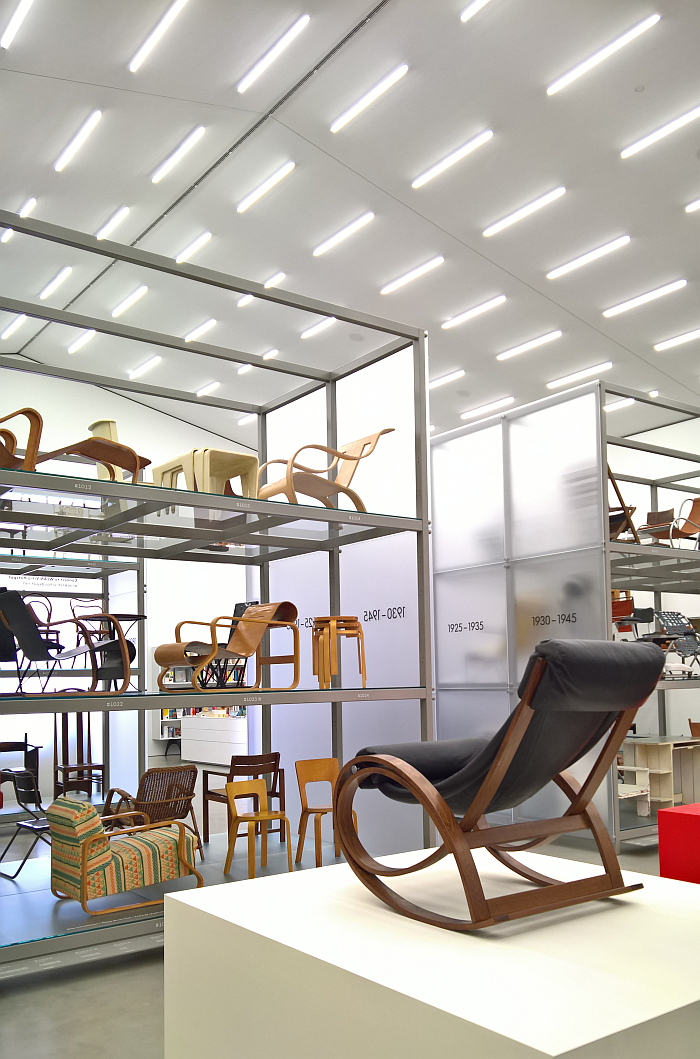
Sgarsul by Gae Aulenti for Poltronova in dialogue with Alvar Aalto, as seen at Gae Aulenti: A Creative Universe, Vitra Design Museum Schaudepot
Part of a collection of garden furniture released by Poltronova, the Locus Solus armchair owes much not only to Loos, the Knieschwimmer being arguably more present than in Sgarsul, Thonet and inter-War tubular steel, but, also, takes up developments and evolutions of the deck chair, something also seen in, for example, Battista & Gino Giudici’s 1935 Lido chair which stands in Locus Solus’s near vicinity; and in doing so Aulenti creates a much more domestic, civil, though no less free and easy object than its forbearer. A freedom and ease that comes in no small measure from the Pop Art upholstery and brightly coloured steel tubing.
Brightly coloured steel tubing and Pop Art upholstery Zanotta replaced with monotone upholstery and chrome plated tubing for indoor version’s of some of the Locus Solus chairs and tables; a collection, arguably, much more likely to win Adolf Loos’s approval, if for us, lacking the personality of the Poltronova version.
And certainly lacking the exuberance and humour.
Characteristics further reflected in the Locus Solus armchair by the ever delightful knick in the back legs, a knick which is important in helping achieve the necessary stability and required seating angle, but which gives the impression that the tubular steel frame is tugging just a little too tight. And an exuberance and humour regularly, though not consistently, found in Aulenti’s works.
Not unsurprisingly. Humour, exuberance, character were/are regular and recurring themes of design in Italy in the 1960s, 70s, 80s, facets of post-War design in Italy whose origins are, for us, most neatly summed up by Ettore Sottsass’s, (purported) “when I was young, all we ever heard about was functionalism, functionalism, functionalism. It’s not enough. Design should also be sensual and exciting”7, a position which has obvious parallels to the motivations of the Neolibertarians; and humour, exuberance, character which, and again, generalising to the point of inaccuracy, Gae Aulenti rarely used as provocatively, as predominantly, as directly, as, for example, a Sottsass or an Alessandro Mendini, but rather, and when she uses it, keeps it in the background, it is a much more subtle element of her compositions, one which rather than make a statement helps bring a certain, undeniable, lightness to her works, stops her works taking themselves overly seriously, frees them from any mistaken belief in their own importance and thereby allowing them to integrate themselves into a variety of spaces. Something not just understood by the overly tight bracing of the Locus Solus armchair, but, for example, in the word TOAST on the front of her 1996 toaster for Trabo.
And a lightness of touch in many regards continued in her flirtations with Surrealism, a strand of her oeuvre arguably best illustrated in A Creative Universe by Tavolo con ruote for Fontana Arte from 1980: a table inspired by the plywood dolly carts used to move sheets of plate glass round the Fontana Arte factory, Aulenti replacing the plywood with the plate glass itself to create an effortlessly endearing and highly refined occasional table, a readymade referenced to this day in untold student projects, and a readymade Aulenti herself would reference in her 1993 table Tour, in which she replaces the dolly castors with bike wheels.
A slightly less endearing, if every bit as infectious, “readymade” being Aulenti’s Riccio vase realised in 2003 in context of a long cooperation with Murano glass producer Venini; a vase that may be named in honour of il Riccio, the hedgehog, but which very clearly, and very terrifyingly, predicts SARS-CoV-2.8
Fortunately it’s behind glass. But still terrifying. And a not unpoetic reminder of the fragility of our planet.
Taking you on a, more or less, chronological tour through Gae Aulenti’s product, lighting and furniture design oeuvre, A Creative Universe is not only an invitation to become better acquainted with Gae Aulenti’s product, lighting and furniture design oeuvre, but to become better acquainted with her wider canon. Her creative universe. And for all the interplay between the various galaxies, stars and energies that compose that universe: many of her product, lighting and furniture projects originating as they did in context of architecture, interior and theatrical commissions, including, for example, the injection moulded polyurethane 4794 armchair through Kartell which was originally designed for Fiat showrooms, and which, as with Stringa, celebrates the art of lounging, the loll; the wood and metal Rossini chair, designed in 1984 for Aulenti’s scenography for Ronconi’s production of Rossini’s Il viaggio a Reims, and later taken on by Maxalto/B&B Italia; or the King Sun and Pipistrello lamps created for the Olivetti showrooms in Buenos Aires and Paris respectively.
The former playing with the light transmitting properties of acrylic glass to create an uncomplicated futuristic object in which the lamp shade is there, but isn’t; the latter, arguably, one of Gae Aulenti’s most Neoliberty informed works. Much in the same way that with his 1920s PH lamps Poul Henningsen channelled an idealised depiction of historic lamp designs into contemporary works, so Aulenti with Pipistrello: it could be from a previous century, but definitely can’t be. Is dangerously Art Deco, but is too refined to succumb to that decadent temptation. And a lamp that aside from its formal charms, is telescopic: originally intended to rise from a height of 64 cm to 130 cm, today rising from 66cm to 86cm, and thus allowing it to be used in a wide range of ever changing situations. And thus a work very much in context of Aulenti’s understanding of functionality as being anything but rigid and predefined. Our only real problem with Pipistrello is the name: Pipistrello is Italian for bat. But it is clearly un Medusa. A jellyfish.
Pipistrello of course brings us back to Riccio.
And so best skip quickly on…….
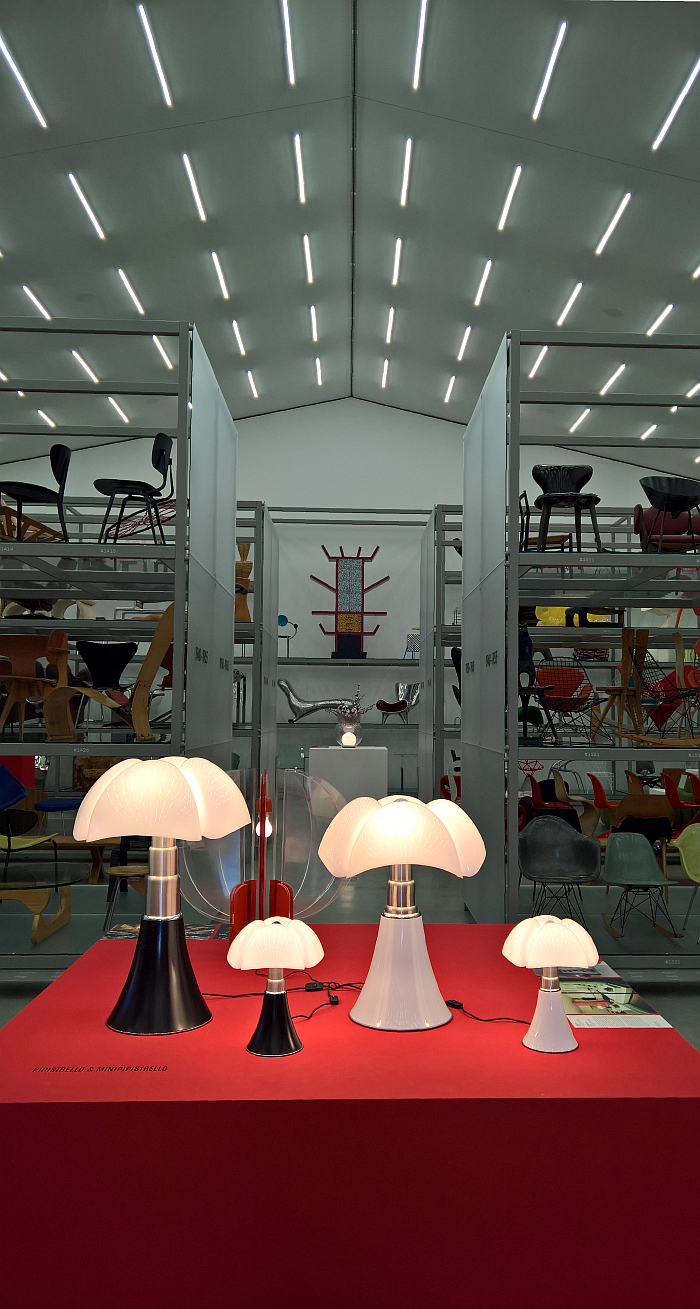
Pipistrello by Gae Aulenti through Martinelli Luce, as seen at Gae Aulenti: A Creative Universe, Vitra Design Museum Schaudepot
Amongst the many joys of A Creative Universe, one of the most satisfying is inarguably the range of work on show; if we’re honest, which we always try to be, we weren’t expecting such a diverse and varied showcase, one that in addition to lighting and furniture also includes home accessories and decorative objects, and were pleasantly surprised to find such.
And a variety and diversity from which our attention was particularly caught by, and amongst other works, Giova from 1964 for Fontana Arte, a combined lamp/vase/sculpture whose principle joy is its scale, as in it is huge, and, we would imagine, can only act as a dominant feature in any given space, but not in a malicious overpowering sense, for that it is far to quiet and reserved a soul; Patroclo from 1975 and in production with Artemide, a lamp not only named after the Greek warrior, and best friend of Achilles, but whose bulging form resembles a muscular human torso, that of a stereotypical Greek warrior, although one clad not in the impenetrable, enchanted armour of Achilles, but a wire mesh, within which the glass is blown and which not only bequeaths the work its subtle charms but also allows for a thoroughly engaging lustre, one that most wonderfully changes depending on your position relative to the lamp. And as with Tavolo con ruote, a production concept that to this day continues to be found amongst student projects, and also in the portfolios of several more established designers.
Then there is Rimorchiatore which the curators describe as, a “hybrid of lamp, vase and ashtray.” And which home doesn’t need just such a multi-function object? Or perhaps better put, didn’t need; as we’ve oft noted in these dispatches, back in the day ashtrays were something designers simply had to consider and integrate. Less so these days. But if, potentially, relaunched as hybrid of lamp, vase and phone charger for the bedside table? What’s not to like?
And a work whose very deliberately considered shapes and volumes allow one to approach an understanding of the care with which Aulenti balances individual components in a composition without necessarily fully integrating them with one another. And that as a general rule she wasn’t one for unyielding quadratic forms; even if the reserved monumentality of the 1965 marble table Jumbo for Knoll indicates she understood such.
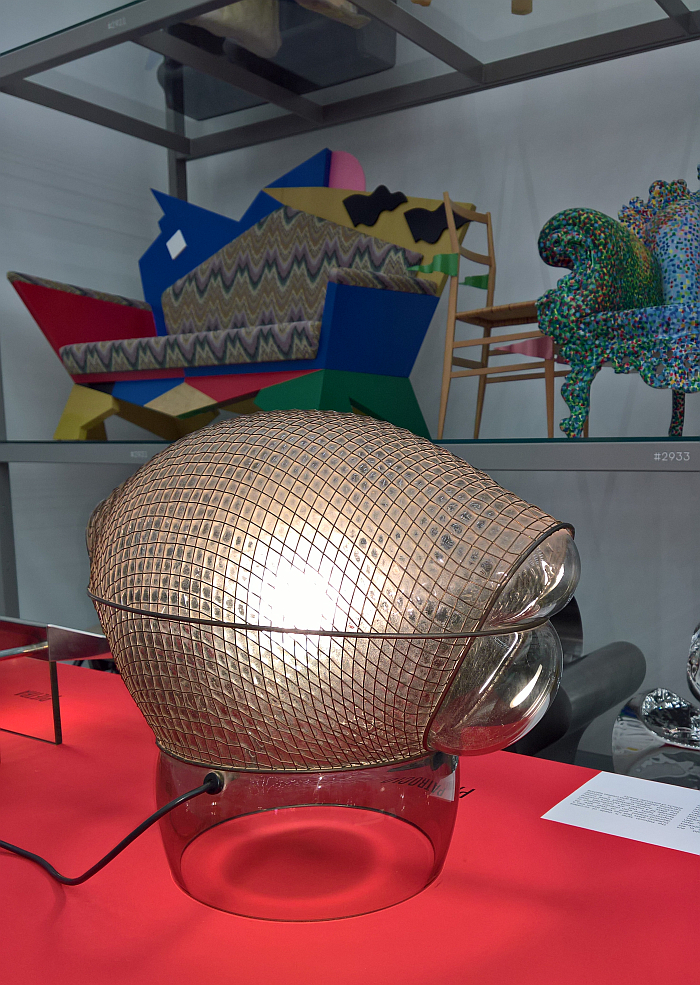
Patroclo by Gae Aulenti for Artemide, as seen at Gae Aulenti: A Creative Universe, Vitra Design Museum Schaudepot
Presenting, in addition to the works themselves, a collection of draughts and sketches, photographs of the works in situ and also video interviews with Gae Aulenti, A Creative Universe allows for a brief, if informative and instructive, bilingual German/English introduction to the design approaches and understandings of Gae Aulenti, and how Gae Aulenti translated those understandings and approaches into objects whose untroubled, simple, elegance oft, always?, belies a very methodic, detailed development and/or inherent complexity; but for all an introduction which demands that you research further, explore deeper in to the creative universe you are being offered but a glimpse of.
Research which, as ever in context of presentations in the Vitra Design Museum Schaudepot, is immediately aided and abetted by the presentation being in the Vitra Design Museum Schaudepot: surrounded as you are by a century and bit of furniture design history, and thus well placed to approach better understandings of not just Gae Aulenti’s designs but how Gae Aulenti’s designs, approaches, positions and understandings fit into the wider helix of design.
And for all allows one to more confidently approach the question as to if one can define a style in Gae Aulenti’s work…….
Gae Aulenti: A Creative Universe runs at the Vitra Design Museum Schaudepot, Charles-Eames-Str. 2, 79576 Weil am Rhein until Sunday April 18th
In addition, the Vitra Design Museum have extended the presentation of Home Stories: 100 Years, 20 Visionary Interiors until Sunday February 28th, while in the Gallery Typology: An Ongoing Study of Everyday Items has been extended until Sunday January 21st
Full details can be found at www.design-museum.de
And as ever in these times, if you are planning visiting please familiarise yourself in advance with the current ticketing, entry, safety, hygiene, cloakroom, etc rules and systems. And during your visit please stay safe, stay responsible, and above all, stay curious….
- Locus Solus for Poltronova and Ruspa for Martinelli Luce by Gae Aulenti, as seen at Gae Aulenti: A Creative Universe, Vitra Design Museum Schaudepot
- 4794 armchair for Kartell (r) and Rossini chair by B&B Italia (l), as seen at Gae Aulenti: A Creative Universe, Vitra Design Museum Schaudepot
- Tavolo con ruote by Gae Aulenti for Fontana Arte, as seen at Gae Aulenti: A Creative Universe, Vitra Design Museum Schaudepot
- Stringa two-seater sofa for Poltronova and Oracolo lamp for Artemide, both by Gae Aulenti, as seen at Gae Aulenti: A Creative Universe, Vitra Design Museum Schaudepot
- Gae Aulenti: A Creative Universe, Vitra Design Museum Schaudepot
- Rimorchiatore (r) and Mezzopileo (l) by Gae Aulenti, as seen at Gae Aulenti: A Creative Universe, Vitra Design Museum Schaudepot
- Jumbo by Gae Aulenti for Knoll, as seen at Gae Aulenti: A Creative Universe, Vitra Design Museum Schaudepot
- April by Gae Aulenti for Zanotta, as seen at Gae Aulenti: A Creative Universe, Vitra Design Museum Schaudepot
- Locus Solus armchair by Gae Aulenti for Poltronova, as seen at Gae Aulenti: A Creative Universe, Vitra Design Museum Schaudepot
1. Carol Vogel, The Aulenti Uproar: Europe’s Controversial Architect, New York Times, November 22nd 1987
2. “whomfor” is not an official word. We believe it should be.
3. Amongst the 12 installations 3 were created by collectives – Superstudio, Gruppo Strum, Archizoom – the latter counting Lucia Bartolini amongst their number, and the only other female involved in the Environments section.
4. Emilio Ambasz, Italy: the new domestic landscape achievements and problems of Italian design, Museum of Modern Art, New York, 1972, accessible via https://www.moma.org/calendar/exhibitions/1783/
5. Nuovi disegni per il mobile italiano, 14-27th March 1960, Catalogue, quoted in Renato de Fusco, Made in Italy: Storia del design italiano. Nuova edizione, Altralinea, Florence, 2014
6. Mathias Listl, Gegenentwürfe zur Moderne: Paradigmenwechsel in Architektur und Design 1945-1975, Böhlau, Köln, 2014
7. You will find this quote everywhere, but never referenced. We are still on the trail of its origins, assuming there is one……
8. Not uninterestingly 2003, the year Riccio was created, was the year of the first SARS pandemic. We’re not genuinely suggesting that Gae Aulenti based Riccio on a typical Corona virus, but the similarities are astounding….
Tagged with: Gae Aulenti, Gae Aulenti: A Creative Universe, Schaudepot, Vitra Design Museum, Weil am Rhein
